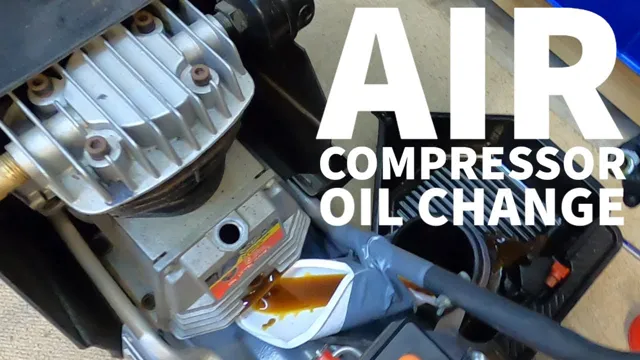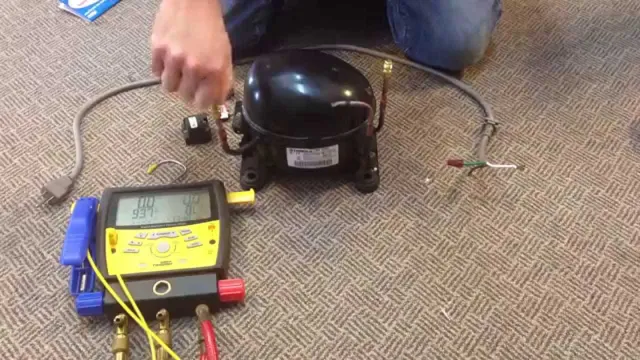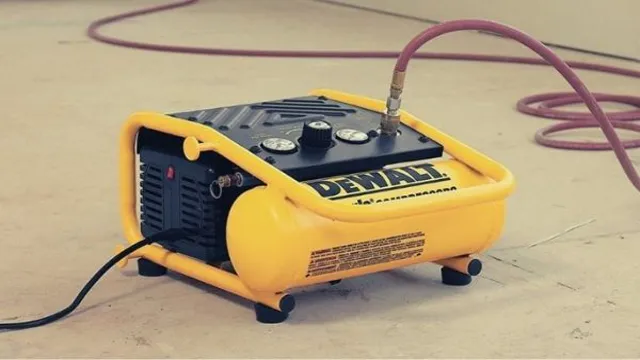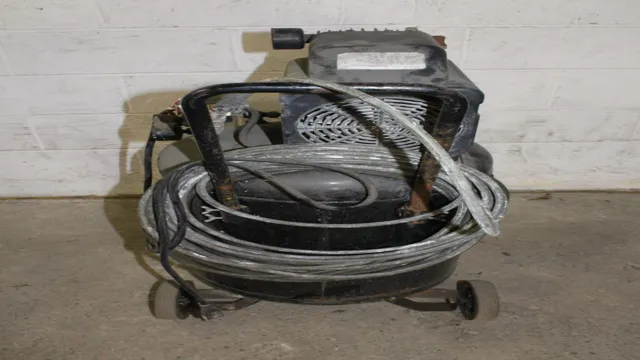How to Change Oil in Craftsman Air Compressor: A Step-by-Step Guide
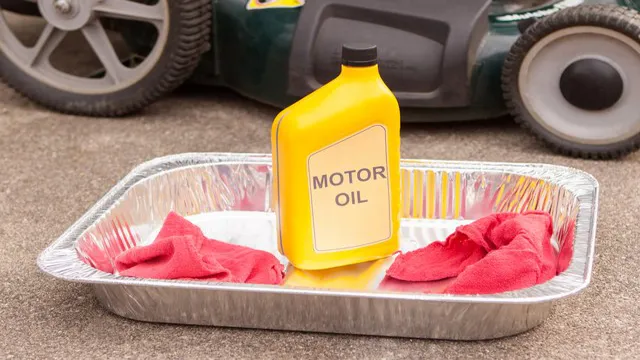
Maintaining an air compressor can be a real challenge if you’re not equipped with the right know-how. One of the most important aspects of air compressor maintenance is changing the oil regularly. This is especially true for Craftsman air compressors.
With proper oil changes, your compressor can run more efficiently and last longer. So, if you’re wondering how to change the oil in your Craftsman air compressor, you’re in the right place! In this blog, we’ll give you all the information you need to change your air compressor’s oil with ease and confidence. From what type of oil to use, to when and how to change it, we’ll cover it all.
So, whether you’re a seasoned DIYer or a newbie, keep reading to learn everything to know about changing oil in Craftsman air compressor.
What you will need
If you own a Craftsman air compressor, changing the oil is vital for maintaining its performance and lifespan. The good news is that this task is simple and can be accomplished with just a few tools. First, you will need to make sure you have the right oil for your compressor.
Check the manual or label to see what type of oil is recommended. Next, you will need a drain pan, a wrench to remove the drain plug, and a funnel to pour the new oil in. A rag or towel may also come in handy for cleaning up any spills.
Once you have these materials, you are ready to begin the process. Remember to always wear protective gloves and eyewear when working with machinery. With these tools and some basic safety precautions, you can easily change the oil in your Craftsman air compressor and keep it running smoothly for years to come.
Oil (specific to your compressor)
When it comes to maintaining your air compressor, oil is an essential component that needs to be regularly checked and replaced. The type of oil you need will depend on the specific make and model of your compressor, so it’s important to refer to the manufacturer’s recommendations. Generally, air compressor oils are a combination of base oils and additives that provide lubrication, prevent corrosion, and improve performance.
Synthetic oils tend to have a longer lifespan and better performance in extreme temperatures, while mineral oils are more affordable and suitable for standard operating conditions. When selecting an oil, it’s also important to consider factors such as viscosity, detergency, and compatibility with other materials in your compressor system. Failing to use the correct oil or neglecting regular oil changes can lead to decreased efficiency, damage to internal components, and costly repairs.
Make sure to check your compressor’s oil levels and condition on a regular basis to ensure optimal performance and longevity.
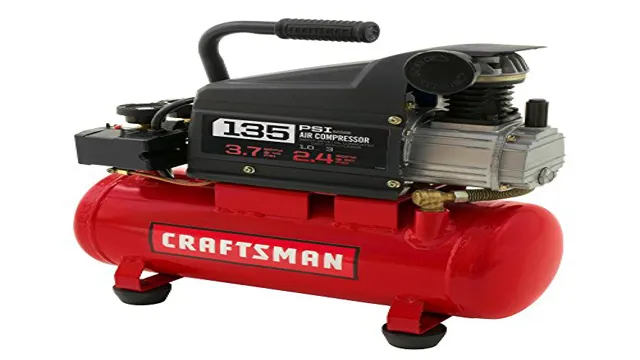
Oil filter wrench
If you’re a DIY enthusiast or a mechanic, an oil filter wrench is an essential tool that you can’t do without. Changing your car’s oil filter is crucial to keep the engine running smoothly, and a wrench makes the task much easier. To get started, you will need an oil filter wrench that fits your car’s make and model.
Make sure to select a wrench with a comfortable grip and a sturdy construction. You’ll also want to ensure that the wrench fits the oil filter snuggly without slipping. Some other helpful items to have on hand include a drain pan, latex gloves, and old rags to clean up any spills that may occur during the filter change process.
With the right tools, you can effectively maintain your vehicle, and save time and money in the process.
Towel or cloth
When it comes to drying off after a shower or bath, you have a few options. The most common are towels or cloths. Both have their pros and cons, so it really comes down to personal preference.
Towels are larger and can cover more surface area, making them great for wrapping around your body. They also tend to be more absorbent than cloths, which is a plus if you have a lot of water to get rid of. However, towels take up more space and can take longer to dry.
Cloths, on the other hand, are smaller and easier to store. They are also quicker to dry and can be washed more easily. However, they may not be as effective at getting you completely dry, which could be a problem if you want to avoid feeling damp.
Ultimately, the choice between towel or cloth comes down to your personal preference and lifestyle. If you have the space to store towels and want something that will quickly get you dry, towels may be the way to go. If you prefer convenient storage and easy washing, cloths might be your best bet.
Either way, both towels and cloths will do the trick of getting you dry and ready for the day ahead.
Step by step process
Changing the oil in your Craftsman air compressor is a simple process that can protect your investment and extend its working life. To begin, turn off the power and relieve any pressure from the compressor tank. Then, locate the oil fill cap and the oil drain valve.
Place a container under the drain valve and open it to release the old oil. Next, remove the fill cap and add the recommended type and amount of oil. Double-check the oil level with the dipstick before replacing the cap.
Finally, start the compressor and let it run for a few minutes to distribute the new oil throughout the system. Remember to change the oil regularly according to the manufacturer’s guidelines, as running the compressor with dirty oil can cause damage to the internal components. Following these steps will ensure efficient and reliable performance from your Craftsman air compressor.
Step 1: Turn off the compressor and unplug it
When it comes to maintaining your air compressor, it’s important to know how to safely turn it off. The first step in this process is to turn off the compressor and unplug it from the power supply. This is especially important if you need to perform any maintenance or repairs on the unit.
Not only does this prevent any accidental startups, but it ensures that you won’t encounter any electrical hazards while working on the machine. Before unplugging the unit, however, make sure to let it cool down and release any built-up pressure in the tanks. Once you’ve followed these steps, you can safely begin working on your air compressor without worrying about any potential accidents or injuries.
By taking these precautions and following a step-by-step process, you can ensure that your compressor lasts for years to come.
Step 2: Locate the oil drain plug and oil filter
After you have gathered all the necessary tools and supplies, it’s time to find the oil drain plug and oil filter. The oil drain plug is usually located underneath your car and can be found by crawling underneath it. Look for a bolt in the middle of the oil pan at the bottom of your engine.
To make sure you find the plug, consult your car’s owner manual. Once you have located it, place the oil pan underneath it as you prepare to remove the plug. On the other hand, the oil filter is typically located on the side of the engine block or in another accessible location.
However, the location may vary depending on your car’s make and model. Finding the oil filter is not that difficult, as it often looks like a small cylinder with a threaded base. Ensure that the oil pan is positioned accordingly before removing the oil filter.
You can use a filter wrench to remove it by turning it counterclockwise. Don’t forget to check the filter’s rubber gasket to ensure it’s not stuck to the engine block. The oil drain plug and oil filter are vital components in your car’s oil change process, and it’s essential to locate them correctly.
Step 3: Place a towel or cloth under the compressor
compressor, towel, cloth When working with a compressor, it’s essential to keep it as stable as possible. That’s where placing a towel or cloth underneath the machine comes in handy. By doing so, you will prevent it from sliding while in use and also protect your work surface from scratches or damages caused by the compressor’s vibrations.
Plus, the towel or cloth will also help to absorb any moisture or oil that might drip from the compressor. It’s essential to ensure that the towel or cloth is thick enough to withstand the weight of the compressor, especially if it’s a heavy duty model. By following this simple step, you’ll ensure the safety of your compressor, your work surface, and yourself, as well as extend the lifespan of your equipment.
So be sure to have a towel or cloth nearby before you start working with your compressor.
Step 4: Use the oil filter wrench to remove the oil filter
Once you’ve drained all the old oil from your vehicle’s engine and removed the oil drain plug, it’s time to remove the old oil filter. But how do you do it? Don’t worry, it’s easier than you might think. All you need is an oil filter wrench.
This handy tool is specifically designed to fit onto the oil filter and give you the leverage you need to twist it loose. Simply slip the wrench onto the oil filter and turn it counterclockwise. The filter should come loose fairly easily.
Be careful, though, as some oil may still be in the filter. Make sure you have a pan to catch any spills. Once the old oil filter is free, simply discard it and move on to the next step.
Remember, it’s important to always use a new filter with every oil change to keep your engine running smoothly.
Step 5: Allow the oil to drain completely through the drain plug
As you approach the final step of changing your vehicle’s oil, it’s important to let all the old oil fully drain out through the drain plug. This crucial step ensures that you’ve removed all the old oil before adding new. Depending on the size of your engine, it may take a few minutes for the oil to completely drain out.
Make sure you’ve placed a container underneath to catch all the old oil to prevent a mess. Once the oil has stopped dripping, you can reinstall the drain plug and move on to the next step. It’s important to note that even though this is the last step, it’s not necessarily the end of your oil change journey.
Always double-check your vehicle’s owner manual to ensure that you’ve completed all the necessary steps before driving. Once you’re confident that everything is in order, you can feel good about having a fresh start with new oil in your vehicle.
Step 6: Replace the oil filter with a new one and tighten it with the wrench
One essential step in changing your car’s oil is replacing the oil filter with a new one. A worn-out oil filter can hamper your engine’s performance and shorten its lifespan. First, locate the oil filter, which is usually located near the oil pan or engine block.
Next, with an oil filter wrench, loosen the filter by turning it counterclockwise. Be cautious not to let the oil filter fall into the oil pan. Then, remove the old filter, and empty the remaining oil into the pan.
With a clean rag, wipe around the tubing before installing the new filter to create a clean and airtight seal. Screw the new filter into place and then use the filter wrench to tighten it, making sure not to overtighten it. Following these steps will guarantee a fresh oil filter, ensuring a steady stream of clean oil to the engine, and extending your car’s lifespan.
By performing regular oil changes, you’ll keep your car in tip-top condition and avoid expensive repairs down the road.
Step 7: Fill the compressor with the recommended amount of oil
When it comes to filling your air compressor with oil, it’s important to follow the manufacturer’s recommendations. Step 7 in the process is to fill the compressor with the recommended amount of oil. This ensures that the compressor runs smoothly and efficiently, reducing the risk of damage or malfunction.
The amount of oil needed will vary depending on the size and model of your compressor, so be sure to check the manual or contact the manufacturer if you’re unsure. When adding oil to the compressor, it’s important to use the correct type of oil specified in the manual. This will ensure that the oil provides the necessary lubrication and protection for the compressor’s internal components.
Once the correct amount of oil has been added, check the oil level with the dipstick provided and adjust as necessary. Remember, proper maintenance of your compressor will extend its lifespan and keep it running at peak performance.
Conclusion
Changing the oil in your Craftsman air compressor doesn’t have to be a daunting task. By following these simple steps, you’ll have a well-oiled machine that’s ready to blow away your toughest jobs. And who knows, maybe you’ll even have some spare time to finally finish that woodworking project you’ve been putting off.
So go ahead and give your air compressor the spa day it deserves – your ears (and tools) will thank you!”
Changing oil in your Craftsman air compressor is an easy process that you can do yourself. Following these steps will help you maintain the machine and ensure that it runs smoothly for a long time.
Changing the oil in your Craftsman air compressor is vital to its long-term maintenance. Although it may seem like a daunting task, it’s actually quite simple to do by yourself. Here is a step-by-step guide to help you through the process: Step 1: Locate the oil drain plug underneath the compressor.
Place a container underneath to catch the old oil. Step 2: Remove the oil fill cap on top of the compressor and then the oil drain plug using a wrench. Step 3: Allow the old oil to drain out completely and then replace the drain plug.
Step 4: Refill with new compressor oil using the recommended oil type and oil level. Ensure the oil level does not exceed the recommended maximum level. Step 5: Replace the oil fill cap, clean the area around the plug and you’re set! Maintaining an optimal level of oil in your compressor ensures it runs smoothly and efficiently for longer, reducing the need for repairs or replacements.
By following these easy steps, you’ll be able to change the oil on your Craftsman air compressor without any hassle or stress! Keyword: Craftsman air compressor, oil, maintenance, change
FAQs
What type of oil should be used in a Craftsman air compressor?
Craftsman recommends using a synthetic blend compressor oil, such as their own branded oil, or an equivalent with ISO 100 rating.
How often should the oil be changed in a Craftsman air compressor?
The oil should be changed every 500 hours of operation or at least once a year, whichever comes first.
Can I use regular motor oil in a Craftsman air compressor?
No, regular motor oil should not be used in a Craftsman air compressor as it is not designed for the high temperatures and pressures of compressors.
What are the steps to change the oil in a Craftsman air compressor?
First, turn off and unplug the compressor. Then, locate the oil drain plug and drain the old oil into a container. Next, refill with the recommended oil to the appropriate level. Finally, replace the oil cap and turn the compressor back on.
Can I reuse the old oil in my Craftsman air compressor?
It is not recommended to reuse old oil in your compressor as it may contain debris or contaminants that could damage the compressor.
What happens if I don’t change the oil in my Craftsman air compressor?
Failing to change the oil can lead to a build-up of contaminants and debris, reduced performance, and ultimately could cause damage to the compressor.
How do I dispose of the old oil from my Craftsman air compressor?
Old compressor oil should be disposed of properly at a local recycling center or auto parts store. Do not pour it down the drain or dispose of it in the trash.

